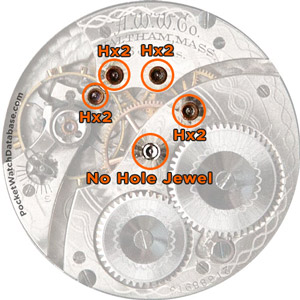Reference Library
Pocket Watch Jewels
Jewels are hard minerals added to the mechanics of the watch to prevent wear at pivot and collision points. Generally, the jewel count is a direct indicator of overall quality.
The standard jeweling configurations for conventional movements are described below. While exceptions exist, the majority of American Pocket Watch movements will follow these arrangements.

7 Jewels
Nearly all conventional American Pocket Watch movements contain at least 7 jewels, located within the balance assembly and escapement:
- One Pair (2) Balance Staff Hole Jewels (Upper/Lower)
- One Pair (2) Balance Staff Cap Jewels (Upper/Lower)
- 1 Impulse/Roller Jewel
- One Pair (2) Pallet Jewels (Right/Left)
7-Jewel movements can be easily identified by the lack of hole jewels at the train bearings on the top plate. Instead of jewels, the bearings are metal bushings.
7-Jewel movements usually are not marked with the jewel count.

11 Jewels
In addition to the 7 jewels located within the balance assembly and escapement, 11-jewel watches contain one of the two following characteristics:
- One Pair (2) Pallet Fork Hole Jewels (Upper/Lower) and One Pair (2) Escape Wheel Hole Jewels (Upper/Lower)
- Or 4 Upper Plate Hole Jewels for the Pallet Fork, Escape Wheel, 3rd Wheel, and 4th Wheel (Without paired hole jewels on the bottom plate)
Because some manufacturers commonly jeweled the top plate only, if the movement is not marked with a jewel count, removal of the dial is usually required to determine the accurate count.
Note: In many cases, 11-jewel movements that are only jeweled on the top plate will be friction/pressed jewels and be characterized with a plain regulator, while 15-jewel movements will feature screw-set jewels and likely a micrometer regulator. While this is a great indicator, exceptions exist.
11-Jewel movements are almost never marked with the jewel count.

15 Jewels
In addition to the 7 jewels located within the balance assembly and escapement, 15-jewel watches contain:
- One Pair (2) Pallet Fork Hole Jewels (Upper/Lower)
- One Pair (2) Escape Wheel Hole Jewels (Upper/Lower)
- One Pair (2) 3rd Wheel Hole Jewels (Upper/Lower)
- One Pair (2) 4th Wheel Hole Jewels (Upper/Lower)
15-Jewel movements are sometimes marked with the jewel count.
Note: If unmarked, removal of the dial is necessary to inspect the plate jeweling and confirm an accurate jewel count. Many 11-Jewel movements are jeweled only on the top plate without corresponding jewels on the pillar plate.

17 Jewels
In addition to the 15 jewels as characterized above, 17-jewel watches contain:
- One Pair (2) Center Wheel Hole Jewels (Upper/Lower)
Note: Some manufacturers produced 16-jewel movements that can easily be mistaken for 17-jewels. These movements have a hole jewel for the center wheel on the top plate, but do not contain a corresponding jewel on the pillar plate. Thus, removal of the dial is usually required to determine the accurate count unless the plate is marked as "17 Jewels." Generally, if the center hole is jeweled and the movement is not marked with jewel count, it is likely 16-jewels.
17-Jewel movements are usually marked with the jewel count.

19 Jewels
In addition to the 17 jewels as characterized above, 19-jewel watches contain one of the two following characteristics:
- One Pair (2) Pallet Fork Cap Jewels (Upper/Lower)
- Or One Pair (2) Mainspring Barrel Jewels (Upper/Lower)
19-Jewel movements are usually marked with the jewel count.

21 Jewels
In addition to the 19 jewels as characterized above, 21-jewel watches contain:
- One Pair (2) Escape Wheel Cap Jewels (Upper/Lower)
21-Jewel movements are always marked with the jewel count except under rare circumstances.

23 Jewels
In addition to the 21 jewels as characterized above, 23-jewel watches contain:
- One Pair (2) Mainspring Barrel Jewels (Upper/Lower)
23-Jewel movements are always marked with the jewel count except under rare circumstances.
24+ Jewels
Some premium watches contain 24+ jewels. However, the extra jewels are typically considered to be superfluous and do not actually improve the movement.